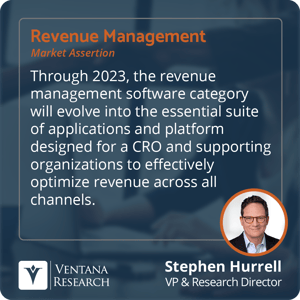As laid out in my recent Analyst Perspective, Revenue Management: The Opportunity for Innovation and Optimization, revenue management is a new way look at generating and managing the top line. It unifies multiple sources: the traditional focus on new customers to existing customers as well as all types of revenue from new, additional channels. This could include customer retention, upsell and cross sell, in addition to other selling channels such as through partners or digital sales channels like e-commerce and subscriptions.
Achieving this enhanced revenue perspective requires a reprioritization and alignment across previously independent teams such as customer service, alliances and partners, marketing and direct sales. Regardless of products and services but especially for subscription and recurring revenue business models customer engagement is a continuous activity that extends beyond the initial sale. The adage that everyone is “selling” is writ large. But this alignment is unlikely to occur by happenstance. It needs to be planned for, measured and continually monitored and adjusted.
This process is supported by revenue operations, coordinating the activities of sales, marketing and customer service. But revenue operations needs to respond to overall revenue goals by setting individual targets that align the different teams to a common objective. As more workers within an organization are categorized in revenue-supporting roles, quotas, territories and incentive compensation should be used to encourage worker behavior that supports the continuous customer engagement model, which should be aligned to revenue performance.
Ventana Research defined the category of sales performance management in 2003 to catalogue the unique needs of sales leaders, managers and operations teams working to align planning and execution with revenue targets. While most in the industry were emphasizing incentive compensation management, it is only a small component of the overall effort to maximize sales performance. A recent paper by my colleague, Mark Smith, explored the science of sales performance management, outlining the basics behind SPM.
 Sales professionals are typically compensated based on commissions and incentives from transactions by assigned accounts in a defined territory. Territories and quotas are constantly adjusted either for personnel changes or in response to market conditions. This approach contrasts with other workers for whom compensation is linked to personal objectives and annual reviews. A common compensation structure can be equally applied to wider teams involved with revenue, including marketing, customer service and partner sales. This will also include digital selling channels such as e-commerce, so the sales team does not feel they are competing with these channels, leading to distorted behavior. In addition, incentive compensation formulas should be made available to all to ensure actions are linked to expected outcomes.
Sales professionals are typically compensated based on commissions and incentives from transactions by assigned accounts in a defined territory. Territories and quotas are constantly adjusted either for personnel changes or in response to market conditions. This approach contrasts with other workers for whom compensation is linked to personal objectives and annual reviews. A common compensation structure can be equally applied to wider teams involved with revenue, including marketing, customer service and partner sales. This will also include digital selling channels such as e-commerce, so the sales team does not feel they are competing with these channels, leading to distorted behavior. In addition, incentive compensation formulas should be made available to all to ensure actions are linked to expected outcomes.
To meet these broader needs, sales performance management is evolving into what we call revenue performance management (RPM). RPM manages revenue across all channels, departments and types, employing all activities and processes of governance and leadership. Reaching full revenue potential requires applications and technology that support analytics and planning to guides teams and individuals to maximize outcome.
In addition to including a wider group of individuals in revenue targets and incentive compensation calculations, revenue operations is also involved in ensuring that data supports tracing the customer journey from lead through the sale to onboarding, implementation, sustained adoption and expansion. New metrics have already evolved in the RPM industry to link these revenue channels to all stages of the customer’s journey.
For successful revenue performance management, traditional sales forecasting must be revamped. Revenue forecasting is more than a traditional sales forecast and requires more data science as well as methods to effectively manage the unified forecast. For example, new direct sales are only one part of the larger revenue picture. Customer retention and sustained adoption – often defined as renewals – are key to expansion. In addition, digital sales channels need to be incorporated into this forecast as more organizations use digital options to complement traditional sales channels for non-enterprise customers and expansion opportunities. These opportunities need to be included in the overall revenue forecast that helps drive resource allocation for the rest of the organization as well as providing core revenue projections for finance and the chief financial officer.
We recommend that the chief revenue officer and revenue operations team identify what is required to manage revenue performance for the month, quarter and year. Examine how the unification of data from across revenue channels and departments can be combined into a common analytics model and used for a variety of activities and processes. Elevating the need for compensation, incentives, forecasting, quotas, resources, rewards and territories from the traditional direct-sales approach to the revenue management level requires having a portfolio of applications and tools that utilize analytics to effectively forecast and plan to expected quotas across the organization. Use compensation and incentive schemes resulting from consistent and accurate data to create targets from all revenue sources to manage income from existing and new customers. Ensure all types of revenue from renewals to subscriptions, direct, partner or e-commerce channels are integrated for a unified approach. Artificial intelligence can play a role in helping triangulate between a bottom-up and top-down approach to revenue forecasting, providing validation of assumptions and judgment for new sales prospects, customer churn and expansion opportunities.
Evaluate vendors and software, recognizing that a specific version of revenue operations and intelligence technology may not meet your larger needs for RPM. Focus on what your organization needs and discuss with vendors how products meet those needs ̶ not just today, but over time, and for use by leadership, managers and operations teams across all departments and channels of revenue. Carefully consider whether products support the short-term, tactical needs of revenue operations, yet fail to map to the overall responsibility of the CRO and the aims of revenue management.
This new category of revenue performance management is the most strategic and operational focus that a CRO and revenue operations team can embrace. This will help not only the CRO and team to achieve their targets, but will benefit the entire organization, including the CEO and CFO.
Regards,
Stephen Hurrell


 Sales professionals are typically compensated based on commissions and incentives from transactions by assigned accounts in a defined territory. Territories and quotas are constantly adjusted either for personnel changes or in response to market conditions. This approach contrasts with other workers for whom compensation is linked to personal objectives and annual reviews. A common compensation structure can be equally applied to wider teams involved with revenue, including marketing, customer service and partner sales. This will also include digital selling channels such as e-commerce, so the sales team does not feel they are competing with these channels, leading to distorted behavior. In addition, incentive compensation formulas should be made available to all to ensure actions are linked to expected outcomes.
Sales professionals are typically compensated based on commissions and incentives from transactions by assigned accounts in a defined territory. Territories and quotas are constantly adjusted either for personnel changes or in response to market conditions. This approach contrasts with other workers for whom compensation is linked to personal objectives and annual reviews. A common compensation structure can be equally applied to wider teams involved with revenue, including marketing, customer service and partner sales. This will also include digital selling channels such as e-commerce, so the sales team does not feel they are competing with these channels, leading to distorted behavior. In addition, incentive compensation formulas should be made available to all to ensure actions are linked to expected outcomes.








